True/False
Indicate whether the
statement is true or false.
|
|
|
1.
|
An object dropped from a window falls to the ground. The position-time graph
representing the object's motion would be a straight line.
|
|
|
2.
|
A car accelerates uniformly when the traffic light turns green. The
velocity-time graph representing the car's motion would be a straight line.
|
|
|
3.
|
The slope of the tangent to a point on a curve that is part of a position-time
graph represents the instantaneous velocity.
|
|
|
4.
|
A velocity-time graph that consists of a straight non-horizontal line represents
an object that is travelling with uniform motion.
|
|
|
5.
|
The slope of the line that joins two points on a velocity-time graph represents
the average acceleration during that time interval.
|
|
|
6.
|
Consider a trip from your home to your school and back home again. The magnitude
of your displacement is equivalent to your distance travelled.
|
|
|
7.
|
The valve on the tire of a bicycle that is travelling due west at a constant
speed is exhibiting "uniform motion."
|
|
|
8.
|
An object is thrown vertically upward. At the top of its flight, both the
object's velocity and acceleration are momentarily zero.
|
|
|
9.
|
The slope of a position-time graph represents the velocity.
|
|
|
10.
|
Consider one complete orbit around Earth as taken by astronauts aboard a space
shuttle. The magnitude of the average velocity is equivalent to the average speed.
|
Multiple Choice
Identify the
choice that best completes the statement or answers the question.
|
|
|
11.
|
The term "uniform motion" means
a. | acceleration is constant | d. | displacement is
constant | b. | speed is constant | e. | velocity is zero | c. | velocity is
constant |
|
|
|
12.
|
An 80.4-km trip takes a time of 0.75 h to complete. The average speed, expressed
in the correct manner, is
a. | 107.2 km/h | d. | 1 ´ 102
km/h | b. | 1.072 ´ 102 km/h | e. | 1.1 ´
102 km/h | c. | 29.8 m/s |
|
|
|
13.
|
The position-time graph pictured below represents the motions of two objects, A
and B. Which of the following statements concerning the objects' motions is true? 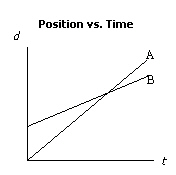 a. | Object B travels the greater distance. | b. | Object A has the greater
speed. | c. | Object A leaves the reference point at an earlier time. | d. | Both objects have
the same speed at the point where the lines cross. | e. | Object A is travelling for a longer period of
time. |
|
|
|
14.
|
The position-time graph pictured below represents a race between three
contestants A, B, and C. The race begins at time zero at the sound of the starter's pistol.
Which of the following statements is true? 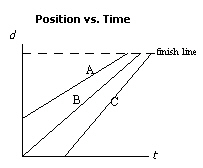 a. | The runner who started last finished first. | b. | The fastest runner
won the race. | c. | The runner with a head start won the race. | d. | Only one runner
began at the sound of the starter's pistol. | e. | All runners ran the same
distance. |
|
|
|
15.
|
The position-time graph pictured below depicts a person, P, running to catch a
bus, B, that has just begun to pull away. Which of the following statements is true? 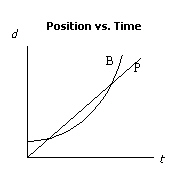 a. | The person has no chance of catching the bus. | b. | The person's
acceleration is greater than that of the bus. | c. | The person has two opportunities to catch up to
the bus. | d. | The speed of the bus is always greater than that of the person. | e. | The person's
speed is always greater than that of the bus. |
|
|
|
16.
|
The position-time graph that represents "uniform motion" is 
|
|
|
17.
|
Consider the following velocity-time graph and select the statement that is
true.  a. | At no time can the motion be considered "uniform." | b. | The object returns
to its original position. | c. | The object travels in one direction and then
the other. | d. | The object is accelerating throughout the entire recorded time. | e. | The object speeds up
and later slows down. |
|
|
|
18.
|
The following velocity-time graph depicts the motions of two objects, A and B.
Which of the statements describing the graph is true? 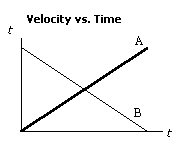 a. | Both objects are accelerating uniformly. | b. | The two objects are
travelling in opposite directions. | c. | Both objects start from
rest. | d. | Object A travels farther than object B. | e. | Object B travels
farther than object A. |
|
|
|
19.
|
Four of the five graphs pictured below could all represent the same motion.
Which graph does not belong to this group? 
|
|
|
20.
|
A pilot flies to a destination due north from the departure point. During the
flight there is a wind blowing from the west. What direction must the pilot point the plane during
the flight?
a. | due east | d. | due west | b. | east of north | e. | west of north | c. | due
north |
|
|
|
21.
|
A car drives 6.0 km [E], then 8.0 km [S] in a total time of
0.30 h. What is the car's average speed?
a. | 33 km/h | d. | 47 km/h [E of S] | b. | 47
km/h | e. | 47 km/h [S of
E] | c. | 33 km/h [E of S] |
|
|
|
22.
|
Over a period of 3.0 s a car's velocity changes from 18 m/s [W]
to 12 m/s [W]. What is the value of the car's acceleration during this time?
a. | 2.0 m/s2 [E] | d. | 10 m/s2
[E] | b. | 10 m/s2
[W] | e. | 2.0 m/s
[E] | c. | 2.0 m/s2 [W] |
|
|
|
23.
|
A car is driving along the highway behind a slower vehicle when it pulls out to
pass. If the car's acceleration is uniform at 2.0 m/s2 for 4.0 s and it reaches a
speed of 28 m/s, what was its speed when it first pulled out to pass the slower vehicle?
a. | 18 m/s | d. | 24 m/s | b. | 20 m/s | e. | 26 m/s | c. | 22
m/s |
|
|
|
24.
|
The position-time graph below depicts the motions of two objects, A and B. Which
of the following statements concerning the objects' motions is NOT true? 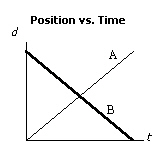 a. | The two objects have the same speed. | b. | The two objects travel the same
distance. | c. | The two objects travel with uniform motion. | d. | The two objects
travel for the same amount of time. | e. | The two objects have the same
velocity. |
|
|
|
25.
|
A bus drives 40.0 km [E] from town A to town B, then another 30.0 km
[S] to town C in a total time of 1.00 h. What are the values of its average speed and
average velocity, respectively?
a. | 70.0 km/h, 70.0 km/h [37º S of E] | d. | 50.0 km/h, 70.0 km/h [37º
S of E] | b. | 70.0 km/h, 50.0 km/h [37º S of E] | e. | 50.0 km/h [37º S of E], 70.0
km/h | c. | 50.0 km/h, 50.0 km/h [37º S of E] |
|
|
|
26.
|
The slope of a velocity-time graph represents
a. | displacement | d. | acceleration | b. | average velocity | e. | distance | c. | instantaneous
velocity |
|
|
|
27.
|
The area under an acceleration-time graph represents
a. | displacement | d. | instantaneous velocity | b. | change in
velocity | e. | average
speed | c. | average velocity |
|
|
|
28.
|
A boat always points directly at the opposite shore while crossing a river. The
time it will take to cross will be
a. | less if the current is stronger | b. | greater if the current is
stronger | c. | the same regardless of the current | d. | dependent on the strength of the
current | e. | impossible to predict without more information |
|
|
|
29.
|
To cross a river with a current in the least amount of time, a boat should
point
a. | directly at the opposite shore | b. | somewhat upstream | c. | somewhat
downstream | d. | in a direction that will take the boat directly across | e. | in a direction that
will take the boat slightly upstream |
|
|
|
30.
|
Three identical boats set out to cross a river that has a current. Boat A points
directly across the river, boat B points 20º downstream from a point straight across the river,
and boat C points 20º upstream from a point straight across the river. Which boat will arrive on
the opposite shore first?
a. | boat A | b. | boat B | c. | boat
C | d. | it is impossible to tell with the information given | e. | all three boats will
arrive at the same time |
|
Matching
|
|
|
Study the velocity-time graph pictured below and match each segment of the
graph with the description of its motion at that time.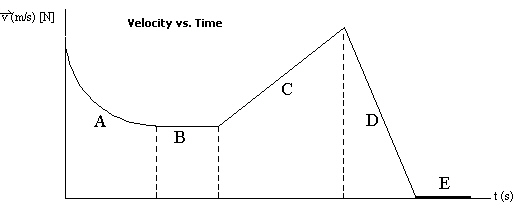 a. | segment A | d. | segment D | b. | segment B | e. | segment E | c. | segment
C |
|
|
|
31.
|
The object is motionless during this segment.
|
|
|
32.
|
The object is moving with constant velocity during this segment.
|
|
|
33.
|
The object travels the greatest distance during this segment.
|
|
|
34.
|
The object is experiencing non-uniform acceleration during this
segment.
|
|
|
35.
|
The object is travelling north but accelerating south during this
segment.
|
|
|
Match the item with the correct statement below. a. | change in velocity | c. | acceleration | b. | average velocity | d. | displacement |
|
|
|
36.
|
Found by taking the slope of a position-time graph.
|
|
|
37.
|
Found by taking the slope of a velocity-time graph.
|
|
|
38.
|
Found by taking the area under a velocity-time graph.
|
|
|
39.
|
Found by taking the area under an acceleration-time graph.
|